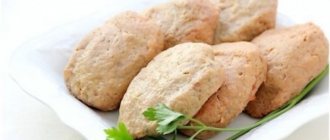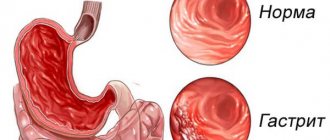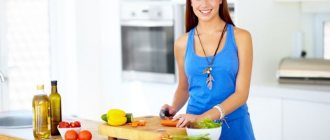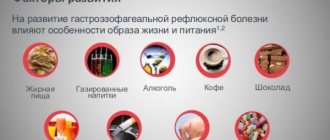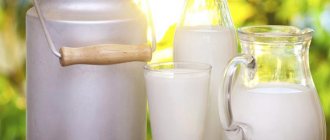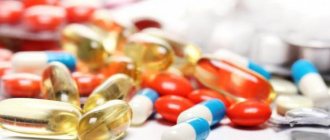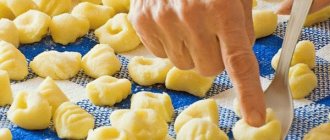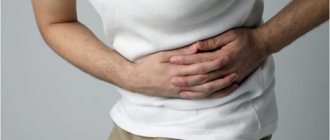- September 10, 2018
- Gastroenterology
- Nadezhda Devlyashova
Often, diseases of the gastrointestinal tract are formed through the fault of the person himself; the cause is often food addictions that do not meet the rules of a healthy diet. A diet for reflux gastritis can help you get rid of the disease, in most cases forever. Doctors have long confirmed the fact that diets make it possible to cope with many diseases. By following simple rules, the patient can independently improve his health, forget about illnesses, or at least achieve stable remission.
Reflux esophagitis, reflux gastritis
Irregular eating behavior is characterized by irregular eating, overeating, large amounts of food before bed, excessive amounts of carbonated drinks, coffee, tea, alcohol, and fast food. This leads to problems with the gastrointestinal tract, gastritis and reflux. Diet in such cases can correct the situation.
Smoking and the Helicobacter bacteria have a detrimental effect on the gastric mucosa.
If the functions of the sphincter are impaired, it ceases to provide protection, the barrier to acid does not work and it is thrown into the esophagus. The mucous membranes become irritated, acid aggression contributes to the development of chronic inflammation (reflux esophagitis). Symptoms of the disease are heartburn, belching of food or air, a feeling of heaviness.
With reflux gastritis, disturbances are observed in the work of the pylorus. In this case, reflux occurs from the duodenum into the stomach. The food thrown back contains admixtures of aggressive acid and bile. The stomach cannot cope with such an environment, and its walls become inflamed. In addition to drug treatment, it is necessary to follow a diet for reflux gastritis. Only an integrated approach can stop the development of inflammation.
Useful video about diet for gastritis
As a rule, the normal process of digestion involves the “processing” of food consistencies, and gastric juice is involved in the process. After passing the stage, the finished mass is sent to the duodenum. The movement of food into the intestines is accomplished with the help of the timely function of the pylorus. Thanks to a special valve, the mass passes specifically to the desired area without returning to the stomach.
When the pylorus malfunctions, digestion is disrupted. Incompletely processed food mixed with bile fluid returns back to the stomach. The mucous walls of the stomach begin to become inflamed, accompanying the process with characteristic symptoms: bloating, nausea, vomiting, diarrhea, constipation, sudden weight loss, etc. Typically, such signs indicate a malfunction of the digestive system.
Any disease associated with the digestive tract is accompanied by adherence to a diet. Thanks to such treatment during the acute period, the patient will avoid various injuries and the development of a number of pathologies. Reflux esophagitis is considered a common gastrointestinal disease. Malaise often manifests itself through heartburn, belching and nausea after eating foods.
The diet for esophagitis and gastritis is to protect the stomach and restore proper functioning. It implies important rules for observing therapeutic nutrition, permitted and prohibited types of foods during treatment.
Danger of Reflux
If the patient does not want to change his lifestyle, does not give up bad habits, and continues to eat improperly, with reflux esophagitis, acid will constantly be thrown into the esophagus and injure the mucous membrane. This leads to the formation of erosions and ulcers on the walls. Next, connective tissue scars begin to form in these places, and they, in turn, lead to stenosis of the esophagus, when its lumen narrows. The most serious complication is the transformation (degeneration) of epithelial tissues into cancer cells.
With superficial reflux gastritis, new cells also form in the stomach in place of the affected cells. The digestion process is disrupted and there is a risk of cancer. The erosive type threatens to develop into an ulcer. Atrophic reflux gastritis is the most dangerous and is a precancerous condition.
What is a treatment table for reflux esophagitis?
The principle of nutrition for reflux esophagitis is a mechanically and chemically gentle diet.
For this disease, the patient is assigned to treatment table No. 1 according to Pevzner. You have to constantly follow or adhere to this table in case of chronic form of reflux esophagitis. In case of acute course or exacerbation of the disease, the doctor prescribes table No. 1 b.
Table No. 1 is prescribed to patients with diseases of the digestive system
Amount of nutrients per day:
- fats 100 g;
- proteins 90–100 g;
- carbohydrates up to 400 g;
- sodium chloride 10–12 g.
Food should not irritate the mucous membranes of the stomach and esophagus or stimulate the production of hydrochloric acid, or cause bloating. The energy value per day is 2500–2800 kcal. Free fluid per day – 1.5 liters.
Reflux gastritis: treatment, diet
Complications of the disease pose a great danger to life, so you should not neglect the symptoms; you must immediately seek medical help. After conducting a diagnostic examination and establishing a diagnosis, the doctor will prescribe treatment. Modern methods will allow you to get rid of symptoms, stop exacerbation and even completely recover from the disease. Treatment of reflux gastritis is always carried out comprehensively, including:
- proper nutrition;
- good vacation;
- healthy sleep;
- drug therapy.
Even the most modern medications that cope with erosions and get rid of reflux will be meaningless if you do not adhere to proper nutrition. Therefore, a diet for reflux gastritis with high acidity is a prerequisite in the fight against the disease.
There are cases when, when treating the initial stages of a disease, a properly selected diet and compliance with nutritional requirements over a long period of time make it possible to cope with the disease without any medications.
Diet for bile reflux
Increasing sphincter tone and cleansing the stomach is important. Traditional medicine is widely used in home treatment. Proven remedies include potato and celery juice, dandelion syrup, and various herbal infusions. If the disease develops severely, a decision may be made to undergo surgery.
Optimizing your diet and regimen is considered one of the most important stages in treating the disease.
What should be in the diet
Meals should be taken frequently up to 5 times, but in measured portions. Food should be soft in consistency, easy to digest and have a comfortable temperature.
The diet is designed taking into account the reduction in the aggressiveness of bile. For biliary gastritis, boiled semi-liquid pureed food is recommended. The consumption of appropriate mineral water should be increased.
Diet principles
A diet for reflux gastritis involves frequent meals, but in small quantities, that is, there should not be a feeling of overeating, but it is not recommended to experience hunger. Use small plates, they will help dose out food and get rid of excess food. You need to eat slowly, without distraction, chewing your food thoroughly. Food should not be too cold or hot. Products can be boiled, steamed or stewed.
After eating, you should not burden yourself with physical labor or, conversely, lie down. Slow walking is recommended. Before going to bed, the last meal should take place no later than two hours, so the food can be processed.
If you smoke, you need to get rid of this bad habit during treatment, or even better - forever. Forget about alcohol and carbonated drinks.
You will have to exclude everything spicy, salty, smoked, fried, and fatty from the menu. These products lead to irritation of the gastric mucosa, causing heartburn and reflux.
Prohibited for use
When treating gastritis, special attention should be paid to diet. Products should help normalize the functioning of the entire gastrointestinal tract, restore intestinal motility, reduce acidity and normalize microflora. A diet for erosive reflux gastritis helps achieve stable remission and relieves many painful symptoms.
For any form of gastritis, you must exclude from your diet:
- Semi-finished products.
- Fatty, hot, salty, spicy, fried, canned foods.
- Sweet carbonated water, alcoholic drinks.
- Sweets, flour confectionery products.
- Products containing harmful food additives and dyes.
- Mushroom and fatty meat broths.
- Mayonnaise, ketchup, sauces.
- Strong coffee, black tea.
- Marinated dishes.
- Hard-boiled eggs.
- Dairy products.
- Flatulence-causing foods (fresh cabbage, black bread, legumes).
- Vegetables, fruits, fresh greens in raw form. They must undergo heat treatment before use.
Treatment
Conservative therapy for reflux includes:
- drug correction;
- physiotherapy;
- alternative methods.
Before prescribing a course of treatment, the reasons for the reflux of bile into the stomach and esophagus are determined. Because the choice of funds depends on many factors. If the patient has undergone surgical correction and does not have a gallbladder, some medications are not prescribed. Treatment is recommended to reduce the symptoms of the pathology.
When there is a reflux of bile into the stomach, a group of drugs is included whose action is aimed at:
- normalization of secretory function;
- improvement of motor skills and passage of food masses;
- restoration of acidity;
- elimination of pain syndrome.
Treatment is prescribed by a gastroenterologist based on objective and additional examination data. The medications presented in the table help get rid of the reflux of bile into the stomach.
Table 1. Drug treatment for the release of bile into the stomach
| Drug groups | Names of tablets | pharmachologic effect |
| Ursodeoxycholic acid | Ukrliv, Ursofalk, Gepaursol, Ursosan | Reduces bile stagnation, restores its composition, improves outflow |
| Prokinetics | Domrid, Motilium | Normalize motor function, reduce the likelihood of reflux, prevent vomiting |
| Choleretic drugs | Allohol, Holosas | Helps thin bile |
| Proton pump blockers | Omeprazole, Omez | Help treat excess secretion, normalize pH balance in the stomach |
| Antacids | Phosphalugel, Almagel, Maalox | Helps reduce irritation of the mucous membrane, create a protective layer on the inner surface of the esophagus and stomach, which neutralizes hydrochloric and bile acids |
| Antispasmodics | Riabal, Dicetel, No-shpa, Mebeverine | Relieves pain, reduces spasm of smooth muscles |
| Analgesics | Paracetamol, Ibuprofen | Relieves pain and discomfort |
The menu for reflux disease includes products that reduce the irritant effect on the mucous membrane of the esophagus and other parts, do not cause gastritis, and normalize the motor function of the digestive tract. A diet for the reflux of bile into the stomach is recommended by a gastroenterologist for the entire period of treatment and during the rehabilitation period.
How to eat right in this case?
To do this, follow these rules:
- Take food in small portions up to 6 times a day.
- Gentle heat treatment of food is allowed: boiling, baking, stewing, steamed dishes.
- You should not eat 3 hours before bedtime.
- Limit the intake of alcoholic beverages, coffee, sparkling water, and juices.
- Avoid fatty, fried, spicy, smoked foods.
- Fruits and vegetables are not eaten raw.
- Avoid snacking and chew food thoroughly.
- The diet should include cereals, soups, milk and ready-made dairy products, and fruit infusions.
When the duodenum and stomach are full of bile, its accumulation causes unpleasant symptoms. Alternative medicine allows you to remove stagnation of secretions and restore their normal release. Healing herbal remedies can be prepared at home. If there is a reflux of bile into the stomach, treatment with folk remedies shows good results and helps get rid of unpleasant symptoms.
Popular recipes are presented in Table 2.
Table 2. Recipes for folk remedies for bile reflux into the stomach
| Natural remedy | Admission rules |
| Chamomile decoction | 15 grams of raw materials are poured into 200 ml of boiling water, brought to a boil and left in a water bath for 10 minutes. Drink ½ glass up to 3 times a day. |
| Dandelion root infusion | 15 grams of crushed raw materials are poured into 200 ml of boiling water and left for 20 minutes. Drink 50 ml 3 times a day. |
| Corn silk | 3 teaspoons of the mixture are poured into 200 ml of boiling water, heated in a water bath for half an hour. Dilute with boiled water 1:1 and filter. Drink ¼ glass before meals. |
What foods can you eat?
A diet for reflux gastritis and reflux esophagitis allows you to include the following products in your meals:
- Meat – rabbit, poultry, lean pork; Fat and skin must be removed before cooking.
- Seafood and lean fish.
- Cereals – buckwheat, oatmeal, millet.
- Bread - whole grain yesterday's baked goods, bran, crispbread, savory crackers.
- Pasta made from durum wheat.
- Vegetables - eggplant, carrots, zucchini, beets, celery, pumpkin, bell peppers, cabbage (all stewed).
- Fruits - sour apples, melon, watermelon, pears, berries, all in small quantities.
- Milk - low-fat fermented milk, cottage cheese.
- Drinks – drinking water, still mineral water, weak tea, herbal decoctions, jelly, non-concentrated compote.
Medical nutrition
Therapeutic nutrition for reflux gastritis plays a major role. The diet consists of easily digestible foods that will provide the body with useful substances and will not cause irritation to the stomach or intestines.
The diet for gastritis consists of normalizing the functioning of the intestine and its microflora, which helps neutralize bile acids and reduce their harmful effects on the stomach.
Dietary food has the following effects:
- Reduced acidity. A special drinking regimen allows you to cope with high acidity, and certain foods help normalize the digestion process.
- Reducing the sensation of pain and heaviness. Allowed products from the diet menu envelop the walls of the stomach and protect from the effects of juice, thereby reducing pain. Small portions are quickly digested and eliminate the feeling of heaviness.
- Accelerating the process of digesting food. Mashed and boiled foods are quickly absorbed in the stomach, and there is almost nothing left for the intestines to digest, therefore, the risk of food being thrown back into the stomach is minimized.
Important nutrition rules for gastritis:
- before meals you should drink a glass of boiled water, which will help reduce stomach acidity;
- eat 5-6 times a day in small portions so as not to overload the stomach;
- avoid hunger and overeating;
- prepare food by boiling, baking or steaming;
- alcoholic drinks should be excluded;
- observe the drinking regime - do not drink during meals, the total volume of liquid is up to 1 liter per day;
- take only warm food; cold or too hot food irritates the stomach;
- exclude late dinners and night snacks, because at this time the intestines are actively working;
- after eating, it is forbidden to lie down due to an increased risk of alkali entering the stomach;
- during an exacerbation of the disease, it is better to eat while standing;
- In the acute stage, it is also undesirable to wear tight belts, because this contributes to intensifying attacks.
If all dietary recommendations are followed, the patient can improve their health in a short time.
Dishes recommended for consumption
The diet for reflux gastritis is very similar to the diet for esophagitis. The basis of nutrition in the treatment of gastritis consists of dishes and products that do not overload the stomach and do not cause excessive production of gastric juice. Dishes should have a semi-liquid, pureed consistency.
You can eat the following foods:
- liquid and half-cooked porridges;
- liquid vegetable and milk soups;
- boiled lean meat, finely pureed or soufflé (chicken, turkey, beef);
- boiled or steamed fish;
- vegetable puree;
- boiled eggs or steamed omelet;
- fresh milk;
- pureed low-fat cottage cheese;
- small amount of butter;
- slightly dried bread;
- compote, weakly brewed tea, herbal decoctions;
- sweet fruits;
- mineral water.
The list of acceptable foods is quite wide and allows you to create a menu for reflux gastritis that will be varied and rich in all useful vitamins and minerals.
Dishes that should be excluded from the diet
When treating gastritis, foods that overload the stomach and may contribute to excess secretion are prohibited.
The following foods should not be eaten:
- Fatty broths based on meat and fish.
- Fermented milk products (kefir, yogurt).
- Citrus fruits and all acidic fruits and vegetables.
- Unripe fruits and vegetables.
- Vegetables that cause fermentation in the intestines.
- High fat cottage cheese.
- All dishes with seasonings, herbs and spices.
- All fried foods.
- Limit the amount of salt.
- Various sauces.
- Mushrooms.
- Smoked and salted products.
- All types of canned food.
- Hard-boiled eggs.
- Coffee.
- Soda and all drinks with carbohydrates.
- Delicious baked goods.
- Coarse bread.
- Honey, jam.
Excluding such products from the menu will help avoid attacks and establish normal functioning of the gastrointestinal tract.
Sample menu for one day
From permitted products, you can prepare a variety of dishes that will be tasty and provide the body with all the necessary substances.
Example menu for one day:
- Breakfast - boiled milk porridge made from oatmeal with a small amount of butter.
- Second breakfast – steamed omelet.
- Lunch – vegetable puree with the addition of boiled beef.
- Afternoon snack – a piece of bread with low-fat cottage cheese, rosehip decoction.
- Dinner – mashed potatoes and steamed fish.
- Second dinner - a glass of herbal tea and a baked apple.
Allowed dishes from the menu
The diet for reflux esophagitis and gastritis allows the following first courses on the menu:
- Chicken or milk soup with the addition of durum wheat vermicelli.
- Vegetable puree soup.
- Vegetarian soups with a vegetable base.
- Fruit puree soups.
The diet must contain all the necessary substances, minerals, and vitamins. Where do you get the main micronutrient protein? From the following products:
- Boiled meatballs or steamed cutlets from lean meats.
- "Doctor's" is a real sausage.
- Kefir, cottage cheese, sour cream, milk - low-fat.
- Stewed or boiled lean fish.
- Steamed egg omelet (no more than twice a week).
The diet includes the following types of side dishes that can be served with cutlets or lean boiled meat:
- Mashed potatoes with water or milk without adding eggs or butter.
- Jacket potatoes.
- Porridges: rolled oatmeal, buckwheat, rice, semolina - all with water.
- Twice a week porridge with milk.
- Vermicelli, pasta with a drop of vegetable oil.
Sample menu for one day
We focus on freshly prepared products.
Breakfast : buckwheat porridge with milk and butter.
Second breakfast : bread toast with unleavened cottage cheese.
Lunch : vegetable puree soup and meat soufflé.
Afternoon snack : baked apple, dry cookies, compote.
Dinner : steamed fish with mashed potatoes. Herb tea.
Many diseases can be successfully treated with nutrition. This promotes rapid recovery of the body and normalization of well-being. By following a diet and strictly following your doctor’s recommendations, you can improve your health and establish normal digestion. Nutrition is the basis of health with reflux gastritis.
Author : Svetlana Nikolaevna Golubeva, especially for the site Moizhivot.ru
Recipes
A diet for reflux gastritis for every day may seem difficult to follow only at first glance. A nutritionist will help you create a menu for the week, describe the correct combination and quantity of foods, and their calorie content. Next, you will just need to experiment, alternate these dishes and change places every day of the week.
The recipes below will help you diversify your diet and treat yourself to healthy, delicious dishes.
So, the recommended breakfast includes delicious semolina-oatmeal porridge with dried fruits. To prepare it, you will need: half a glass of semolina, half a glass of oatmeal, low-fat milk - half a liter, chopped dried apricots and prunes - two tablespoons.
Preparation: bring the milk to a boil, mix the cereals together and gradually pour them into the heated milk, add dried fruits. Cook for five minutes. Close the lid and let the porridge sit for ten minutes. Breakfast is ready.
A diet for exacerbation of reflux gastritis allows you to include a delicious dish on the menu that is suitable for both lunch and dinner.
Products: permitted boiled vegetables (any); boiled chicken fillet, herbs, salt, low-fat sour cream.
Boil vegetables that are acceptable on the diet. Separately cook the chicken fillet. Place everything in a blender glass and pour in some vegetable broth. Turn the whole mass into puree soup. This hearty and nutritious dish is suitable for both lunch and dinner.
